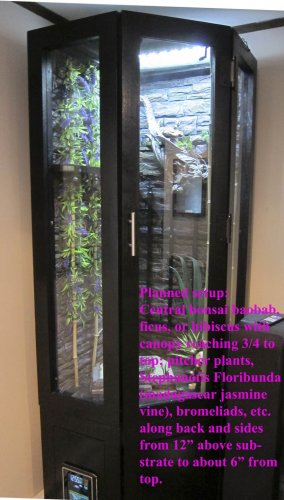Franquixote
Established Member
I'm in the planning stages of planning an Ambilobe region biome to set up a panther chameleon and thought I'd share some information and see if anyone else wants to come along for the ride.
Beyond the gratification, knowledge, and authenticity of such a setup I think it's always wise to try and duplicate the native region of any species kept in captivity for the health of the species. I personally get a lot of satisfaction from learning and studying a species this way.
I began a different thread but I'm starting this one since some initial questions have been answered.
I have an offer for you at the end too if you want to try this out with me.
I'm going to try and attach some resources as this progresses, and keep my focus on the Northeastern Ambilobe region of Madagascar; feel free to swipe whatever resources and info you want to if you'd like to start your own thread on a different region.
I've decided to begin with looking into vanilla orchids, pitcher plants, and a few other plants and dwarf trees that will provide some value beyond the ornamental. I like the idea of having edibles both in my home landscaping and in other hobby projects.
The pitcher plants are a draw for me not because of their edibility, but their inherent interest as a species and the thought that they may guard against uneaten feeders wandering around too long and either escaping, chewing things up, or desensitizing the chameleon from readily and immediately accepting food when offered.
I also think they may perhaps draw in some flying insects through a screen top which might add some free variety to the diet of the chameleon, and unlike crawling insects that may make their way into the enclosure are less likely to be exposed to pesticides.
I'll update and attach information as I discover it.
I happen to already have growing some edible native plants from Madagascar, Houttuynia cordata... also known as... the CHAMELEON PLANT!
http://www.eol.org/pages/595460/overview
As a new member I'd like to offer as a gesture of good will toward this forum clippings or small plants for anyone that's interested. I'd only ask you cover the shipping (or if you want me to try and mail one in an envelope I'll spring for the stamp). The plant is attractive and edible, it has a citrus smell but definite undertones of ether or diesel. It's widely used in some cuisines and grows in other places like Vietnam. My only complaint is that it's so easy to grow that you shouldn't put it anywhere it can spread because it will take over and become invasive quickly. A planter or pot is safe.
Hope I get some others interested, I'll be looking to source some vanilla orchids soon along with a few dwarf fruit trees and pitcher plants. I have pretty decent access to exotic plants so don't anticipate having any trouble acquiring anything.
Hope to update soon.
Beyond the gratification, knowledge, and authenticity of such a setup I think it's always wise to try and duplicate the native region of any species kept in captivity for the health of the species. I personally get a lot of satisfaction from learning and studying a species this way.
I began a different thread but I'm starting this one since some initial questions have been answered.
I have an offer for you at the end too if you want to try this out with me.
I'm going to try and attach some resources as this progresses, and keep my focus on the Northeastern Ambilobe region of Madagascar; feel free to swipe whatever resources and info you want to if you'd like to start your own thread on a different region.
I've decided to begin with looking into vanilla orchids, pitcher plants, and a few other plants and dwarf trees that will provide some value beyond the ornamental. I like the idea of having edibles both in my home landscaping and in other hobby projects.
The pitcher plants are a draw for me not because of their edibility, but their inherent interest as a species and the thought that they may guard against uneaten feeders wandering around too long and either escaping, chewing things up, or desensitizing the chameleon from readily and immediately accepting food when offered.
I also think they may perhaps draw in some flying insects through a screen top which might add some free variety to the diet of the chameleon, and unlike crawling insects that may make their way into the enclosure are less likely to be exposed to pesticides.
I'll update and attach information as I discover it.
I happen to already have growing some edible native plants from Madagascar, Houttuynia cordata... also known as... the CHAMELEON PLANT!
http://www.eol.org/pages/595460/overview
As a new member I'd like to offer as a gesture of good will toward this forum clippings or small plants for anyone that's interested. I'd only ask you cover the shipping (or if you want me to try and mail one in an envelope I'll spring for the stamp). The plant is attractive and edible, it has a citrus smell but definite undertones of ether or diesel. It's widely used in some cuisines and grows in other places like Vietnam. My only complaint is that it's so easy to grow that you shouldn't put it anywhere it can spread because it will take over and become invasive quickly. A planter or pot is safe.
Hope I get some others interested, I'll be looking to source some vanilla orchids soon along with a few dwarf fruit trees and pitcher plants. I have pretty decent access to exotic plants so don't anticipate having any trouble acquiring anything.
Hope to update soon.




